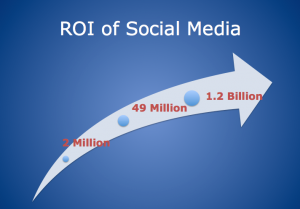Today, more businesses demand their social media marketing campaigns generate ROI (return on investment). A number of tools help with this, including free ones like Google Analytics and Webmaster Tools, and paid tools like Ubervu and Brandwatch. The problem is, these insights are somewhat fragmented. What businesses need is a tool to understand the performance of their social media campaigns holistically.
That’s why I developed the four-factor model of social media performance. Before I get into the components of the model, let’s take a look at the problem.
Measuring the ROI of Social Media
Measuring your social media performance isn’t easy, in part, because your efforts are fragmented across different social platforms – Facebook, Twitter, your blog, etc. Firms are drowning in all this data, so the bigger problem is knowing what to measure.
Measuring vanity metrics (such as fans, followers and similar expressions of the size of your network) doesn’t help a lot because there’s little correlation between vanity metrics and market performance. Measuring conversion misses the role of micro-conversions (Google’s term for actions leading to conversion). For instance, actions such as sharing impact conversion by amplifying the brand message to more eyeballs.
So, what’s a brand to do?
Related Class: How to Measure Social ROI for Your Client
The Four-Factor Model
It seems to me a brand needs a single metric capable of evaluating the overall performance of their social media campaign. A single metric allows firms to track performance over time, compare different campaigns and compare performance across brands. Certainly, firms need to drill down from this single metric to understand factors contributing to performance once they have the initial metric.
A single performance metric must include both conversion (sales, leads, sign-ups) and micro-conversions (actions contributing to conversion). Within micro-conversions I include both the sales funnel (i.e., the clicks visitors take to complete the conversion such as placing a product into a shopping cart or viewing FAQs) and actions unrelated to the sales funnel directly, such as social shares that amplify the brand message while adding personal recommendations.
I’m still refining the model, but currently, it looks like this:
ROI = amplification X sentiment X marketing intensity X close rate
Let’s look at each factor and why I included it in the model. I welcome comments and suggestions for improving the model.
Amplification
Amplification increases awareness of your brand. But, more important, a share is an implied endorsement of your brand by folks who most influence buying decisions – friends. Shares also morph a brand’s image based on characteristics of who does the sharing. For example, if a trendy friend recommends a particular sweater or new restaurant, you’re much more likely to give it a try.
Now, I have a proprietary algorithm developed to assess amplification using scoring for individual pieces of content, but you can create your own simple measure of amplification by adding up all the post Likes, +1s, shares, RTs, etc. Or, maybe you weight different types of shares differently since a recent study published on MOZ shows a different impact for Google +1s, Facebook and Twitter on search results.
Sentiment Analysis
Sentiment analysis measures your brand image – do folks like it or hate it? Obviously, folks buy brands they like and, by extension, brands their friends like. While all sentiment analysis tools have major problems, Radian6 is a good option for gathering sentiment.
Marketing Intensity
Here, we include marketing efforts like coupons, traditional and online advertising spend, maybe some overall measure of content marketing efforts such as number of posts and other factors representing marketing activities.
Close Rate
Your close rate includes conversions, but might also include some other conversion-type factors such as your CTR (click-through rate) for your emails or online advertising, although these might represent your conversion.
Using the Four-Factor Model
First, you can weight any factor in the model as you see fit. Second, you can weight individual elements of each factor. For instance, you might weight sales more than requests for information or other types of lead generation.
You might also add additional factors to the model. Additions I’m playing with include engagement (e.g., comments), weighting actions by influencers based on their Klout score or other mechanism or weighting elements based on the size of the network so that Facebook has a higher weight than Pinterest.
An additional factor to consider is assessing crowdsourced content or other types of user-generated content as a separate factor or including it in the amplification factor.
Now, I recognize using the Four-Factor Model is a little challenging since it isn’t something you can do by simply combining numbers from a single report. Implementation requires either some BI (business intelligence) savvy or a clunky manual process. If you’re a developer, I’m happy to discuss how you might make money developing a SAAS to calculate results based on the model.
As mentioned earlier, you’ll still need to drill down with existing analytics tools to get a more nuanced picture of your social media campaigns. However, despite implementation challenges, I think the Four-Factor Model goes a long way toward addressing how and where ROI is created in your social media marketing campaigns, which allows optimization of those campaigns. I welcome your comments for improving the model.

